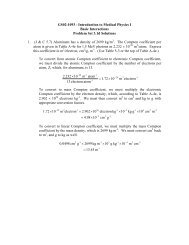link to lecture transcript - UT-H GSBS Medical Physics Class Site
link to lecture transcript - UT-H GSBS Medical Physics Class Site
link to lecture transcript - UT-H GSBS Medical Physics Class Site
You also want an ePaper? Increase the reach of your titles
YUMPU automatically turns print PDFs into web optimized ePapers that Google loves.
So what is the effect of binding energy? Here is a plot of Comp<strong>to</strong>n coefficients<br />
versus pho<strong>to</strong>n energy for a free electron gas, oxygen, and lead. We see the curve<br />
for the free electron gas on <strong>to</strong>p; below that is the curve for oxygen; the lowest<br />
values are for lead.<br />
First of all, notice the binding energy only has an effect on the Comp<strong>to</strong>n coefficient<br />
at low energies; once you get above 100 keV, the binding energy essentially has no<br />
effect.<br />
Binding energy is more important for higher Z materials. This also makes sense.<br />
So the impact of binding energy on Comp<strong>to</strong>n coefficient is most noticeable for high-<br />
Z materials.<br />
In general, if we look at energies where the Comp<strong>to</strong>n effect is the predominant<br />
interaction, the effect of binding energy is not significant.<br />
39





